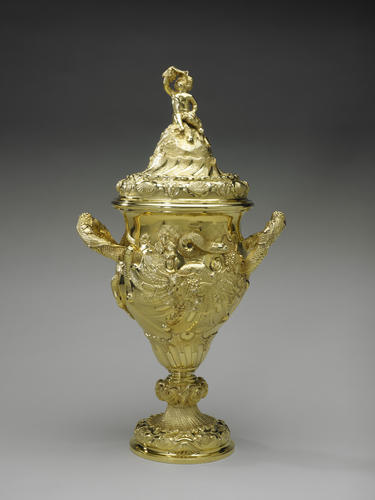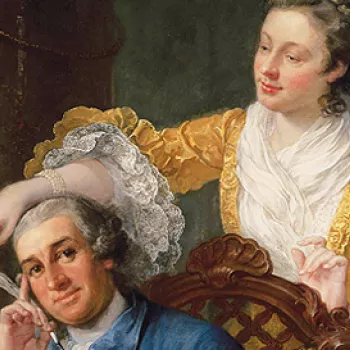Attributed to Paul de Lamerie (1688-1751)
Cup and cover c.1740
Silver gilt | 45.0 x 24.0 x 16.2 cm (whole object) | RCIN 51016







-
A silver gilt cup and cover, the finial cast as a putto eating grapes, seated on a rock, with a border of rams' masks and shells. The urn-shaped body is embossed and chased with snakes, vines and shells and has two handles cast as vine-entwined snakes. The cup is supported on a short knopped stem and circular foot chased with rocaille-fluting.
This cup appears in the ledgers of George Wickes, goldsmith to the Prince of Wales, on 24 January 1740, as a ‘fine cheased gilt cup and cover’ costing £61 3s. Although unmarked it bears many close similarities to a number of other works by Paul de Lamerie, including the Bath Cup, presented by Frederick, Prince of Wales, to the city of Bath on his visit in 1738. Another cup, marked by de Lamerie in 1737, which has identical handles in the form of entwined serpents weaving in and out of the body of the cup, is found in the Fishmongers’ Company. Many of the decorative elements of RCIN 51016 relate to other works by de Lamerie – particularly the putto finial with its dimpled limbs and high forehead, and the exuberant asymmetric shell and scale elements decorating the cup, which are reminiscent, for example, of the coffee pot made for Sir John Lequesne in 1738 (Christie’s London, 4 July 2013, lot 48).
Paul de Lamerie was of Huguenot descent. He was made free of the Goldsmiths’ Company in 1713 and thereafter worked in Windmill Street, St James’s, and later in Gerrard Street in Soho. Despite his appointment as royal goldsmith in 1716, he does not appear at that date to have supplied the Jewel Office, and no bill for his work has been traced. RCIN 51016 belongs to the acknowledged high point of Lamerie’s output, in the late 1730s and early 1740s. This purple patch includes a group of pieces created for Grey Maynard, 5th Baron Maynard (1679-1745), including the famous Maynard sideboard dish of 1736 (now in the Cahn Collection, St Louis). In these years Lamerie also produced exceptionally inventive ewers and basins for Stephen Fox, Earl of Ilchester (c.1740, private collection), the Goldsmiths’ Company (1741/2, Goldsmiths’ Hall, London) and Algernon Coote, 6th Earl of Mountrath (1742, Gilbert Collection, London). All of these pieces show a highly developed use of rococo ornament and asymmetrical design, and display modelling of exceptional quality. It has been suggested that they relate to a particular craftsman in the Lamerie workshop, traditionally known as the ‘Maynard modeller’ after the Maynard sideboard dish. This modeller remains unidentified but may be related to the Kändler family who were so instrumental in the development of the Meissen factory in Dresden.
The 1832 inventory of plate records that the cup belonged to Princess Augusta. This is not mentioned in Wickes’s bill, but it may have been a gift to her from her husband, or she may have claimed it after his death, to prevent it being absorbed into the Jewel Office.
Text adapted from The First Georgians; Art and Monarchy 1714 - 1760, London, 2014.Provenance
Acquired by Frederick, Prince of Wales, 24 January 1740.
-
Creator(s)
Acquirer(s)
-
Medium and techniques
Silver gilt
Measurements
45.0 x 24.0 x 16.2 cm (whole object)








